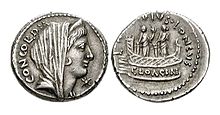Cloacina

Cloacina, "The Cleanser" (from the Latin verb cluo, "to cleanse", from which also cloaca, "sewer, drain"[1]) was a goddess who presided over the Cloaca Maxima ("Greatest Drain"), the main trunk outlet of the system of sewers in Rome. The Cloaca Maxima was said to have been begun by Tarquinius Priscus, one of Rome's Etruscan kings, and finished by another, Tarquinius Superbus: Cloacina might have originally been an Etruscan deity. According to one of Rome's foundation myths, Titus Tatius, king of the Sabines, erected a statue to Cloacina at the place where Romans and Sabines met to confirm the end of their conflict, following the rape of the Sabine women. Tatius instituted lawful marriage between Sabines and Romans, uniting them as one people, ruled by himself and by Rome's founder, Romulus. The peace between Sabines and Romans was marked by a cleansing ritual using myrtle, at or very near an ancient Etruscan shrine to Cloacina, above a small stream that would later be enlarged as the main outlet for Rome's main sewer, the Cloaca Maxima. As myrtle was one of Venus' signs, and Venus was a goddess of union, peace and reconciliation, Cloacina was recognised as Venus Cloacina (Venus the Cleanser). She was also credited with the purification of sexual intercourse within marriage.[2][3][4]

The small, circular shrine of Venus Cloacina was situated before the Basilica Aemilia on the Roman Forum and directly above the Cloaca Maxima. Some Roman coins had images of Cloacina's shrine. The clearest show two females, presumed to be deities, each with a bird perched on a pillar. One holds a small object, possibly a flower; birds and flowers are signs of Venus, among other deities. The figures may have represented the two aspects of the divinity, Cloacina-Venus.[5]
References[]
- ^ Marchant, James Robert Vernam; Charles, Joseph Fletcher (1904). Cassell's Latin dictionary : Latin-English and English-Latin. London: Cassell and Company. pp. 103.
- ^ Eden, P.T., "Venus and the Cabbage," Hermes, 91, (1963), p. 457, citing Pliny the Elder, Natural History, Book 15, 119 – 121.
- ^ Pliny the Elder, Natural History, 15, 119, cited in Wagenvoort, Hendrik, "The Origins of the goddess Venus", in Pietas: selected studies in Roman religion, Brill, 1980p. 180.
- ^ William Smith, A Dictionary of Greek and Roman biography and mythology, London, John Murray, perseus, Tufts, entry for "Venus"
- ^ Coarelli, Filippo. Rome and Environs: An Archaeological Guide. p. 50.
Further reading[]
See also[]
- Love and lust goddesses
- Roman goddesses
- Toilet goddesses
- Sewerage
- Ancient Roman mythology stubs
